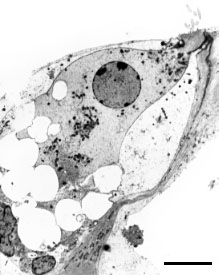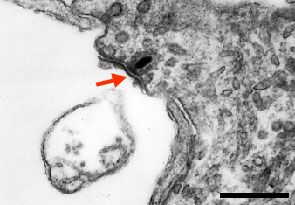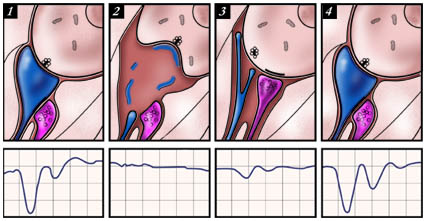Excitotoxicity
Authors: Rémy Pujol, Jean-Luc Puel
Contributors: Sam Irving
One major factor for cochlear neurons pathology is excitotoxicity. This is due to an excess release of glutamate, the IHC neurotransmitter. Excitotoxicity occurs when IHCs are damaged, suffer or die. This is why cochlear neurons are affected by ototoxicity, acoustic trauma, or local ischemia (which may be the main mechanism of neural prebycusis).
Recent findings have also involved excitotoxicity in triggering some tinnitus.
Excitotoxic injury at endings of auditory nerve
Immediately after perilymphatic perfusion with glutamate, or its agonists such as AMPA or kainate, all afferent dendrites below the IHC are swollen, their membranes are ruptured and their cytoplasmic content is lost (left). At higher magnification (right), a remnant of the postsynaptic membrane (red arrow) faces a presynaptic body. The IHC is disconnected from the auditory nerve and cochlear potentials are lost.
The same type of damage occurs immediately after acoustic trauma or ischemia but it can be blocked by an AMPA antagonist such as DNQX. A protective effect of dopamine, a lateral efferent neurotransmitter, is also observed.


scale bar: 10 µm (Left); 0,3 µm (right)
Synaptic repair after an excitotoxic injury

1) Normal synaptic complex below an IHC: a presynaptic body in the IHC faces an afferent dendrite (blue), which itself is contacted by a lateral efferent vesiculated ending (pink). The cochlear action potential is normal.
2) Acute excitotoxicity: the bouton of the afferent dendrite has ruptured and only remnants of its membrane are seen; a piece of the postsynaptic membrane is still attached to the presynapse. Cochlear action potential is absent.
3) 1 day post injury: the afferent dendrite has begun to grow upwards and some filopodia already reach the IHC. In the meantime the widow efferents are directly contacting the IHC. Cochlear action potential begins to recover.
4) 5 days post injury. The normal synaptic pattern is found again, resulting in full functional recovery, demonstrated by the compound action potential.
Notes.
– In man, this mechanism is probably the basis for recovery after sudden deafness caused by ischemia or noise trauma.
– At stage 2 and 3, the nerve ending undergoes drastic changes, some of them because an over-expression of NMDA glutamate receptors may trigger abnormal spontaneous firing, which is probably the origin of tinnitus.
– After repetitive excitotoxic injuries, the repair mechanism will stop when the neurone itself dies.